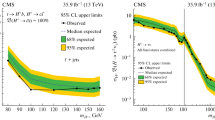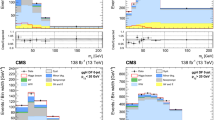Abstract
During run 2016 at LHC, the total recorded luminosity is 35.9 \(\text {fb}^{-1}\) by CMS detector [1]. Measurements of properties of Higgs boson can be determined where Higgs decaying to oppositely charged W bosons and W again decaying leptonically. Events are selected on basis of oppositely charged leptons pair, large missing transverse energy and with different number of jets in final state. Higgs producing from vector boson fusion and associated production with W and Z boson are also included on the basis of two jets and three or four leptons in final state. After Combining all these events corresponding to total integrated luminosity 35.9\(\text {fb}^{-1}\), total calculated cross-sectional times branching ratio is 1.28 ± 0.17 times the standard model prediction for the Higgs boson with a mass of 125.09 GeV [2].
Access provided by Autonomous University of Puebla. Download conference paper PDF
Similar content being viewed by others
6.1 Introduction
Electroweak symmetry breaking is achieved through the prediction of a neutral scalar particle known as Higgs boson after the introduction of complex doublet scalar field which also leads masses of W and Z bosons [3]. Higgs was observed by CMS and ATLAS combined at 7 and 8 TeV using Run 1 dataset and the observed mass of Higgs is \(\text {m}_\text {H}\) = 125.09 ± 0.21(stat) ± 0.11(syst)GeV.
This paper reports decay of Higgs boson to oppositely charged W boson using 2015 and 2016 dataset at center of mass energy of 13 TeV at total integrated lumi- nosity of 35.9\(\text {fb}^{-1}\). The large branching fraction of Higgs to WW, makes this chan- nel to study cross section of Higgs production through gluon–gluon fusion (ggH), vector-boson fusion (VBF) and associated production of Higgs (VH) [4]. In fully leptonic decay of W boson is the cleanest channel despite having presence of neutrino in final state which prevents clear mass peak of Higgs signal.
6.2 CMS Detector
CMS is situated at one collision point of 27 Km large hadron collider (LHC) which accelerated the proton at nearly the speed of light in clockwise and anti-clockwise direc- tion and then collide them. CMS is designed in a compact shape to measure energy and for the tracking of particles. It uses magnetic field of 3.8T for bending of charge particle and to measure momentum accordingly. Charge particle trajectories are measured with silicon pixel and tracker detector, which covers center pseudo-rapidity of \(\eta \) \(\le \) 2.5. It consists of ECAL, HCAL, and muon system, where electron and photon deposits their energy in ECAL, whereas hadrons in HCAL system. Muon system consists of RPC, drift tube and CSC and Iron yoke.
6.3 Data and Simulated Samples
Events are selected on the basis of one or two electrons and muons. Combination of single or dilepton triggers give total trigger efficiency of more than 98 VBF process which are generated by POWHEG v2 [5].

Out of category, one category can be discussed in detail, since ggH is the main pro- duction mode of Higgs. In ggH production mechanism different flavors final state, the main background process are WW, top, DY and W+jets. WW process can be distinguished from signal by different kinematic properties of leptons. To suppress process of three leptons, lepton \(\ge \) 10 GeV is not allowed in final state. Final state transverse mass is defined as \(\text {m}_{T} = \sqrt{2 \text {p}_{\text {T}}^{\text {ll}}*\text {E}_{\text {T}}^{\text {miss}}[1-\cos \varDelta \phi }]\), which should be greater than 30 GeV; where \(\varDelta \phi \) : angle between di lepton momentum and \(E_{T}^{miss}\) .
A shape analysis based on two-dimensional fit of \(\text {m}_{ll}\) and \(\text {m}_{T}\) in different flavors of ggH is done to extract Higgs signal.


6.4 Source of Systematical and Statistical Uncertainties
-
1.
Source of systematical and statistical uncertainties
-
a.
Experimental Uncertainties: sources are—
luminosity (2.3%), muon momentum (0.2%) and electron energy scale (0.6–1%), jet energy scale uncertainty(<10%), trigger efficiency (<1%).
-
b.
Theoretical Uncertainties: sources are—
ggH theory uncertainties, Parton Shower, QCD scale uncertainty.
-
a.
6.5 Results
Signal strength modifier is defined as the ratio of measured and expected signal of Higgs mass of 125.09 GeV including systematical and statistical uncertainty. A summary of signal strength can be seen in Fig. 6.1.
The combined signal strength modifier is \(\mu \) = \(1.28^{+0.18} _{-0.17}\) = 1.28± 0.10(stat)± \(0.11(sys)_{-0.07}^{+0.10}\)(theo) which means observed significance of Higgs boson is \(\sigma \) = 9.1 and expected value of significance is \(\sigma \) = 7.1 (Fig. 6.2).
6.6 Summary
Using Run 2 data at total integrated luminosity of 35.9\(\text {fb}^{-1}\), \(\text {W}^{+}\), and \(\text {W}^{-}\) events are selected on basis of two, three, or four leptons in final state and large missing transverse energy and same flavor(SF) or different flavors(DF) final state. After combining all category, the observed value of significance is 9.1 \(\sigma \) and expected (Fig. 6.3).
Value is 7.1\(\sigma \). Hence, measured signal strength modifier is \(\mu \) = \(1.28^{+0.18} _{-0.17}\) = 1.28± 0.10(stat)± \(0.11(sys)_{-0.07}^{+0.10}\)(theo).
References
C.M.S. Collaboration, Measurement of Higgs boson production and properties in the WW decay channel with leptonic final states. JHEP 01, 096 (2014). https://doi.org/10.1007/JHEP01(2014)096. arXiv:1312.1129
Measurements of properties of the Higgs boson decaying to a W boson pair in pp collisions at \(\sqrt{s}\)=13 TeV. https://doi.org/10.1016/j.physletb.2018.12.073, arXiv.1806.05246
CMS Collaboration, Observation of a new boson with mass near 125 GeV in pp collisions at \(\sqrt{s}\) = 7 and 8 TeV. JHEP 06 (2013) 081, https://doi.org/10.1007/JHEP06(2013)081, arXiv:1303.4571
HWW team, Common analysis object definitions and trigger efficiencies for the H \(\rightarrow \) WW analysis with 2016 full data. AN-2017/082 (2017)
P. Nason, A New method for combining NLO QCD with shower Monte Carlo algorithms. JHEP 11, 040 (2004). https://doi.org/10.1088/1126-6708/2004/11/040. arXiv:hep-ph/0409146
Author information
Authors and Affiliations
Corresponding author
Editor information
Editors and Affiliations
Rights and permissions
Copyright information
© 2021 Springer Nature Singapore Pte Ltd.
About this paper
Cite this paper
Sharma, A. (2021). Measurements of Property of Higgs with Mass Near 125 GeV, CMS Collaboration. In: Behera, P.K., Bhatnagar, V., Shukla, P., Sinha, R. (eds) XXIII DAE High Energy Physics Symposium. DAEBRNS HEPS 2018 2018. Springer Proceedings in Physics, vol 261. Springer, Singapore. https://doi.org/10.1007/978-981-33-4408-2_6
Download citation
DOI: https://doi.org/10.1007/978-981-33-4408-2_6
Published:
Publisher Name: Springer, Singapore
Print ISBN: 978-981-33-4407-5
Online ISBN: 978-981-33-4408-2
eBook Packages: Physics and AstronomyPhysics and Astronomy (R0)







